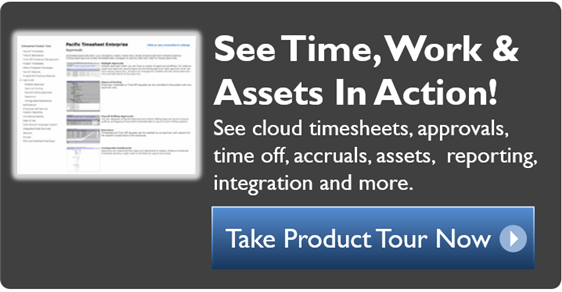Aside from keeping up with changing federal labor rules, it's crucial to stay up to date with local rules and regulations. One big example is the state of California, with complex time and attendance rules that are often difficult to understand and constantly changing. In this post, we'll review California Labor Code’s Meal Periods provision.
Meal Periods
In 2012, a few important changes were made to California’s Meal Periods provision. According to California Labor Code Section 512:
An employer may not employ an employee for a work period of more than five hours per day without providing the employee with a meal period of not less than thirty minutes, except that if the total work period per day of the employee is no more than six hours, the meal period must be waived by mutual consent of both the employer and the employee. A second meal period of not less than thirty minutes is required if an employee works more than ten hours per day, except that if the total hours worked is no more than 12 hours, the second meal period may be waived by mutual consent of the employer and employee only if the first meal period was not waived.
What does this mean?

Legally Obligated Meal Period
For every five hours an employee works, in California, you must provide them with an unpaid, off-duty meal period of at least 30 minutes. If an employee works one minute past those five hours, then you have to pay him a meal penalty (which we will define later). The important thing here is that this 30-minute meal period must allow the employee to be truly off duty. The company and the supervisor has to:- Relieve the employee of all work duties,
- Relinquish control over the employee's activities,
- Permit the employee a reasonable opportunity to take an uninterrupted 30-minute break, AND
- Must not impede or discourage the employee from taking this break.
When this meal period meets these requirements the company can avoid the dread "meal penalty." The meal penalty, for interferring with or not allowing that full 30-minute meal break, is more than you to pay: for each violation of this rule you must pay the employee a penalty of one hour of regular time at their regular rate of pay.
There is one exception to this rule. If an employee works no more than six hours and then he goes home, the meal period can be waived by the mutual consent of both the employer and employee.
Second 30-Minute Meal Period
This meal penalty rule has provisions for longer work days. When an employee works more than 10 hours a day, you must provide a second 30-minute meal period that begins no later than the end of the employee’s 10th hour of work. An employee can waive this second meal period only if:
- The total hours worked on that day are not more than 12 hours,
- The employee and employer mutually consent to waiving the meal period, AND
- The first meal break of the workday was not waived.
On-Duty Meal Periods
Unless an employee is relieved of all his duties during a 30-minute meal period, the meal period is considered “on duty,” will be counted as hours worked, and must be compensated at the employee’s regular rate of pay. “On duty” meal periods are only permitted where:
- The nature of the work prevents an employee from being relieved of all duty, AND
- When the employer and employee have agreed to an on-the-job meal period in a written agreement. The written agreement must allow the employee to revoke this agreement, in writing, at any time.
Because “on duty” meal periods are upheld in only limited circumstances, employers should consult with legal counsel before authorizing “on duty” meal breaks to avoid any potential problems down the road.
Meal Penalty
If employees are required to remain at the work site or facility during the meal period, the meal period must be paid. If an employer fails to provide an employee a meal period in accordance with an applicable Industrial Welfare Commission order, the employer must pay one additional hour of pay at the employee’s regular rate of pay for each day a meal period was not provided.
Additional meal period provisions include:
- Where employees are required to eat on the work premises, a suitable place for eating must be designated, with the exception of workers on construction, drilling, logging, and mining work sites.
- If a meal period occurs on a shift between 10 p.m. and 6 a.m., an employer must provide facilities supplying hot food and drink, or facilities in which food and drink can be heated, as well as suitable shelter in which such food and drink can be consumed.

Rest Breaks
In California, the Industrial Welfare Commission Wage Orders require employers to authorize and permit rest breaks for all nonexempt employees who work a total of at least 3.5 hours. These mandatory rest breaks must be offered at the rate of 10 minutes for every four hours worked, of “major fraction” there of (for example, 2 hours worked). The general rule is that a rest break should, where practical, be taken in the middle of the work period.
Employers should discuss with counsel before departing from this general rule if there are practical considerations that make a break in the middle of the work period.
Rest Break Compensation
Employers must consider rest breaks as hours worked and therefore must pay employees for their rest break time. Because of this, employers can require employees to remain on the premises during their rest breaks.
Rest Break Penalty
In an eight hour work day, if either rest break is not given, an employer must compensate an employee with one hour of work at the employee’s normal pay rate.
Construction Rest Breaks
For employees in on-site occupations like in the construction, drilling, logging, and mining industries, employers may stagger employee rest periods to avoid interrupting the flow of work and to maintain continuous operations. Alternatively, employers may schedule rest periods to occur simultaneously with breaks in the flow of work that occur throughout the course of the workday.
Lactation Accommodation
The California Labor Code also provides that every employer must provide a reasonable amount of break time to accommodate employees desiring to express breast milk for the employee’s infant child. The lactation provision also includes:
- If possible, that a needed lactation break run concurrently with an already provided rest break. If not possible, the employer does not need to compensate an employee for a lactation break.
- Employers must make reasonable efforts to provide employees with the use of a room or other space close to the employee’s workspace, other than a toilette stall, in which the employee can express milk in private.
To keep up with the latest in California meal and rest break rules, see the California Chamber of Commerce’s Meal and Rest Break resource.
Pacific Timesheet’s time and attendance software is one major solution that will allow you to comply with California meal penalty and rest break rules.
What difficulties have you had complying with California meal penalty and rest break rules?
Sources: California Prevailing Wage Laws, California Department of Industrial Relations 1 and 2, California Chamber of Commerce. Images Source: iStock by Getty Images



